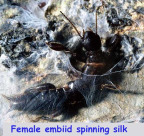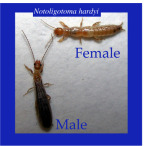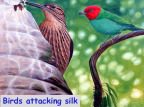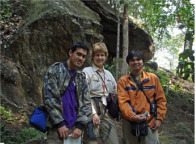
B.A. – State University of New York, Cortland
M.S. – State University of New York, Syracuse
Ph.D. – Cornell University
I teach courses in entomology, ecology, behavior, and biodiversity at SCU. I also take students to Trinidad and Tobago (T&T) during the summer as part of a course on environmental biology and environmental policy (which I teach with Prof. Dennis Gordon of Political Science). Students have also participated in independent research projects in T&T (see The Santa Clara Magazine cover story in the March 1999 issue) working on environmental issues ranging from ethnobotany, environmental awareness, bird and insect censuses to community organization and history. Peg Graham of Anthropology at SCU assisted me in advising the research students.
I investigate questions about the behavior and ecology of insects. I have studied treehole mosquitoes, embiids (webspinning insects) and tent caterpillars. Presently, my students and I are concentrating our attention on the little known group of insects, the embiids (Order Embiidina or Embioptera). I'm working with colleagues at the University of New Mexico and the University of California Riverside on the evolution of silk spinning in embiids.
Read more about my research on my lab website.

I studied webspinners for my Ph.D. work at Cornell University and continued to study them off and on over the years. Mostly my work focuses on basic behavior and ecology of these insects. They remain one of the least known of all the insect orders, perhaps because they are mostly tropical and quite secretive. They live under silken covers and within tunnels that they spin with silk produced by glands in their front feet. My research seeks to determine the level of social organization in these colonial insects, and to discover which factors influence their behavior including their use of silk. I also wish to describe their basic behavior in a detailed manner,because until now most reports are anecdotal. Below I list some of the research problems I am investigating with colleagues and my students.
Silk is spun by insects in three orders: Hymenoptera, Lepidoptera and Emdiidina.
My preliminary analysis of protein composition of embiid silk suggests that their silk varies in the proportions of different amino acids, such as phenylalanine. The silk ranges in color as well from bright white to lavender. These observations suggest that embiid silk has diversified. Our task now is to determine how and why.

How can embiids live in such diverse locations given undefinedthat their body form is so uniform, one species to the next?
Embiid habitats range from humid tropical rain forests to arid, hot climes. Yet their body form is the same in each place; that is, they are elongate, flexible, and fairly soft-bodied for an insect. Females are always wingless and nymph-like. One might expect morphological diversity given the range of climates, but perhaps dwelling within tight silk tubes has selected for their streamlined form. We have discovered recently that embiids may vary physiologically rather than morphologically. I, with Dr. Elizabeth Dahlhoff of SCU, have begun to investigate heat shock proteins in embiids. Our lab data suggest that embiids from mild climes cannot cope with high temperatures whereas embiids from hot areas are resistant to very high temperatures.
I recently have documented ecological correlates of embiid habitats. I started in Australia where two species co-occur on Magnetic Island, but where they seem to use different microhabitats. A detailed survey suggests that each is a specialist to some degree: a lichen-eater and a leaf litter-dweller that have overlapping ranges with slight differences. One striking difference seems to be heat; one of the species lives in astonishingly hot locales.

Embiids vary in their tendency to spin silk although the motions of spinning are probably very similar. Some spin copious amounts whereas others are reluctant to spin at all when removed from their silken domiciles. The latter seems to rely on substrate materials to construct their homes and use silk as an adhesive. The former creates elaborate silk domiciles using the substrate as foundation only. Questions arise: does their variable reliance on silk relate to their tendency to share silk? Are colonial embiids more likely to need and use more silk, and hence can they benefit from sharing? Is it costly to spin? Recent work in my lab suggests that silk spinning is about half as metabolically costly as locomotion. As yet we have not been able to demonstrate a reproductive consequence of silk spinning for three species tested thus far. Embiid silk is constructed of the simplest of all amino acids, those that are readily available to an animal producing such a protein. Perhaps silk is not costly to produce because the amino acids are so ubiquitous in their food. We are still investigating this question. Because silk dominates the lifestyle of webspinners the question deserves to be asked and hopefully answered.

Janice with colleagues Pisit & Praset, collecting embiids in Thailand 2009
- Shaw, S. R. and J. S. Edgerly. 1986. A new braconid genus (Hymenoptera) parasitizing webspinners (Embiidina) in Trinidad. Psyche. 92:505-511.
- Edgerly, J.S. 1987. Maternal behavior of a webspinner (Order Embiidina). Ecological Entomology. 12:1-11.
- Edgerly, J. S. 1987. Colony composition and some costs and benefits of facultatively communal behavior in a Trinidadian webspinner (Embiidina: Clothodidae). Annals of the Entomological Society of America. 80:29-34.
- Edgerly, J. S. 1988. Maternal behaviour of a webspinner (Order Embiidina): mother–nymph associations. Ecological Entomology. 13:263-272.
- Edgerly, J. S. 1994. Is group living an antipredator defense in a facultatively communal webspinner? Journal of Insect Behavior. 7:135-147.
- Edgerly, J. S. 1997. Life Beneath Silk Walls: A Review of the Primitively Social Embiidina. Chapter in The Evolution of Social Behavior in Insects and Arachnids, (Eds. J. Choe and B. Crespi). Cambridge University Press.
- Edgerly, J. S., J. A. Davilla, and N. Schoenfeld. 2002. Silk spinning behavior and domicile construction in webspinners. Journal of Insect Behavior. 15:219-242.
- Szumik, C., J. Edgerly-Rooks and C. Y. Hayashi. 2003. Phylogenetics of Embioptera (=Embiidina). Entomologische Abhandlungren. 61(2):131.
- Edgerly, J. S. and E. C. Rooks. 2004. Lichens, sun, and fire: a search for an embiid-environment connection in Australia (Order Embiidina: Australembiidae and Notoligotomidae). Environmental Entomology. 33(4):907-920
- Edgerly, J. S., A. Tadimalla, and E. P. Dahlhoff. 2005. Adaptation to thermal stress in the lichen-eating webspinners (Embioptera): habitat choice, domicile construction and the potential role of heat shock proteins. Functional Ecology. 19:255-262.
- Edgerly, J. S., S. M. Shenoy*, and V. G. Werner*. 2006. Relating the cost of spinning silk to the tendency to share it for three embiids with different lifestyles (Order Embiidina: Clothodidae, Notoligotomidae, and Australembiidae). Environmental Entomology. 35:448-457.
- Edgerly, J. S., C. Szumik, C. N. McCreedy*. 2007. On new characters of the eggs of Embioptera with the description of a new species of Saussurembia (Anisembiidae). Systematic Entomology. 32(2), 387–395.
- Miller, K. B. and J. S. Edgerly. 2008. Systematics and natural history of the Australian genus Metoligotoma Davis (Embioptera: Australembiidae). Invertebrate Systematics. 22:329-344.
- Collin, M. A., J. E. Garb, J. S. Edgerly and C. Y. Hayashi. 2009. Characterization of silk spun by the embiopteran, Antipaluria urichi. Insect Biochemistry and Molecular Biology. 39:75-82.
- Collin, M. A., E. Camama, B.O. Swanson, J. S. Edgerly and C. Y. Hayashi. 2009. Comparison of embiopteran silks reveals tensile and structural similarities across taxa. Biomacromolecules. 19(8):2268-2274.
- Poolprasert, P. and J. S. Edgerly. 2011. A new species of Eosembia Ross (Embiodea: Oligotomidae) from Northern Thailand. Journal of the Kansas Entomological Society. 84:12-21.
- Collin, M.A., J. S. Edgerly, C. Y. Hayashi. 2011. Comparison of fibroin cDNAs from webspinning insects: insight into silk formation and function. Zoology (Jena). 114(4):239-46.
- Edgerly, J. S., Sebastian Büsse, T. Hörnschemeyer. 2012. Spinning behaviour and morphology of the spinning glands in male and female Aposthonia ceylonica Enderlein, 1912 (Embioptera:Oligotomidae). Zoologischer Anzeiger - A Journal of Comparative Zoology. Doi:10.1016/j.jcz.2011.12.006.
- Proaño, C. B., S. Cruz, D. M. McMillan, J. S. Edgerly. 2012. Exploration of substrate vibrations as communication signals in a webspinner from Ecuador (Embioptera: Clothodidae). Neotropical Entomology. DOI 10.1007/s13744-012-0034-z. Appeared online 4 May 2012.
- Miller, K. B., C. Y. Hayashi, M. F. Whiting, G. J. Svenson, J. S. Edgerly. 2012. The phylogeny and classification of Embioptera (Insecta). Systematic Entomology. 37:550-570.
- Dejan, K. A.*, J. M. Fresquez*, A.M. Meyer*, J. S. Edgerly. 2013. Maternal territoriality achieved through shaking and lunging: an investigation of patterns in associated behaviors and substrate vibrations in a colonial embiopteran, Antipaluria urichi. Journal of Insect Science. 13. Article 82
- Hodson, A. M.*, S.E. Cook*, J. S. Edgerly, K.B. Miller. 2014. Parthenogenetic and sexual species of the genus Haploembia Verhoeff (Embioptera: Oligotomidae) found in California. Insect Systematics and Evolution. 45: 93-113. DOI 10.11163/1876312X-44032095.
- Poolprasert, P. and J. S. Edgerly. 2014. Description of four new species of the genus Ptilocerembia Frederichs, 1923 (Embioptera: Ptilocerembiidae) from Thailand. Zootaxa. 3825 (3): 359-372.
- Addison, J. B., T. O. Popp (ASU*), W. S. Weber, J. S. Edgerly, G. P. Holland, J. L. Yarger. 2014. Structural characterization of nanofiber silk produced by embiopterans (webspinners). Royal Society of Chemistry Advances. Published 5 September 2014 online. DOI: 10:1-39/c4ra07567f
- Büsse, S., T. Hörnschemeyer, Hohu, K*, D. McMillan, J. S. Edgerly. 2015. The spinning apparatus of webspinners-functional-morphology, morphometrics and spinning behaviour. Scientific Reports. 5:9986. DOI: 10.1038/2srep09986.
- Osborn Popp, T. M. (ASU*), J. B. Addison, J.S. Jordan (ASU*), V. G. Damle, K. Rykaczewski, S. L. Y. Chang, G. Y. Stokes, J. S. Edgerly, J. L. Yarger. 2016. Surface and wetting properties of embiopteran (webspinner) nanofiber silk. Langmuir. DOI: 10.1021/acs.langmuir.6b00762.
- McMillan, D., K. Hohu*, J. S. Edgerly. 2016. Choreography of silk spinning by webspinners (Insecta: Embioptera) reflects lifestyle and hints at phylogeny. Biological Journal of the Linnean Society. 118:430–442
- Stokes, G. Y., DiCicco, E. N., Moore, T. J., Cheng, V. C., Wheeler, K. Y., Soghigian, J., ... & Edgerly, J. S. (2018). Structural and wetting properties of nature's finest silks (order Embioptera). Royal Society open science, 5(9), 180893.
- Kelly, E. T., Whittall, J. B., & Edgerly, J. S. (2018). Resolving two Haploembia (Embioptera: Oligotomidae) cryptic species: molecular data confirms parthenogenetic females can be distinguished by their antisocial behavior. Zootaxa, 4504(2), 225-242.
- Salisbury, A., Valkova, V., Reid, S., & Edgerly, J. S. (2019). Aposthonia ceylonica (Embioptera: Oligotomidae), the first established colony of a webspinner to be found in Britain. British Journal of Entomology and Natural History, 32(1), 35-41.
- Edgerly, J. S. (2018). Biodiversity of Embiodea. Insect biodiversity: science and society, 2, 219-244.
- Wipfler, B., Letsch, H., Frandsen, P. B., Kapli, P., Mayer, C., Bartel, D., Edgerly, J.S.... & Simon, S. (2019). Evolutionary history of Polyneoptera and its implications for our understanding of early winged insects. Proceedings of the National Academy of Sciences, 116(8), 3024 3029.
- Büsse, S., Büscher, T. H., Kelly, E. T., Heepe, L., Edgerly, J. S., & Gorb, S. N. (2019). Pressure-induced silk spinning mechanism in webspinners (Insecta: Embioptera). Soft matter, 15(47), 9742-9750.
- Edgerly, J. S., Sandel, B., Regoli, I., & Okolo, O. (2020). Silk Spinning Behavior Varies from Species-Specific to Individualistic in Embioptera: Do Environmental Correlates Account for this Diversity? Insect Systematics and Diversity, 4(2), 2.
- Shenoy, S., Ing, K., Barber Jr, R. P., Rooks, E. C., & Edgerly, J. S. (2020). A Multiscale Characterization of Two Tropical Embiopteran Species: Nano-and Microscale Features of Silk, Silk-Spinning Behavior, and Environmental Correlates of their Distributions. Environmental Entomology, 49(5), 1242-1251.
- Harper, J. R., Sripada, N., Kher, P., Whittall, J. B., & Edgerly, J. S. (2021). Interpreting nature’s finest insect silks (Order Embioptera): hydropathy, interrupted repetitive motifs, and fiber-to-film transformation for two neotropical species. Zoology, 146, 125923.
- Poolprasert, Pisit, K. Tanruen, Senarat, S. & Edgerly, J. S. Diastolembia thailandensis, a remarkable new genus and species of embiids (Embioptera: Embiidae) from Thailand. 2021. Journal of Hunan University (Natural Sciences). 48:57-63.